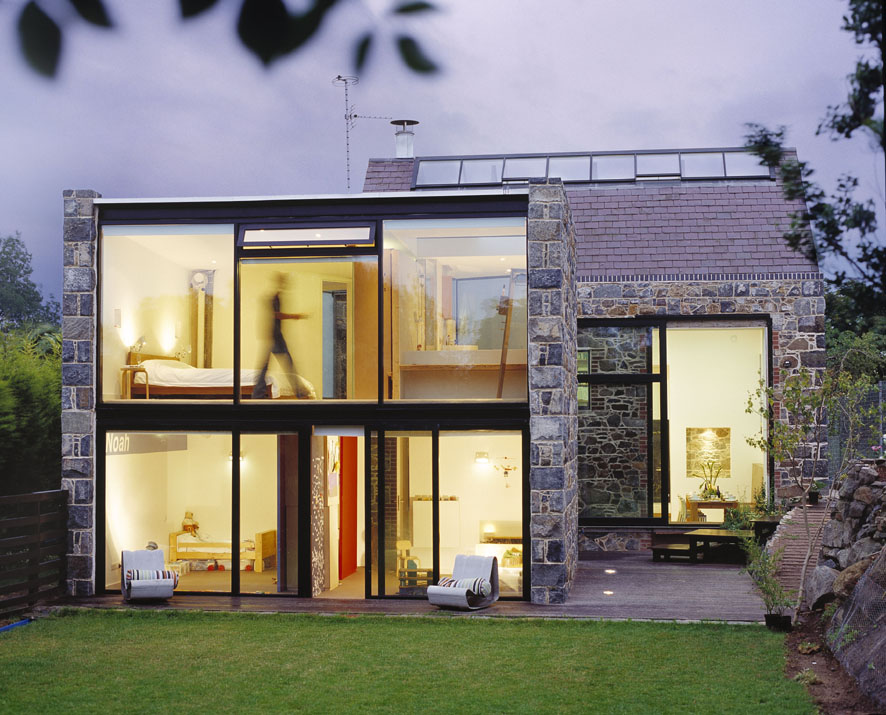We look at whether you need Conservation Area Consent, and how to give your project the best chance of approval.
If you’re planning a home build, renovation or extension, one of the first questions to ask is: am I in a conservation area? It can have significant implications for design, cost and programme. This is particularly pertinent in London and historic UK cities (Bath, Durham, Oxford, etc.) where conservation areas are widespread.
Extension design above by Jamie, architect from Guernsey. See more and shortlist them for your home project here.
Buying in a conservation area? Get clarity before you commit
Pre-purchase due diligence can save you from buying a property that can’t deliver the layout, extension or materials you’re banking on.
The Potential House offers impartial, architect-led appraisals before you buy. We don’t take on follow-on design work, so the advice is objective and focused on feasibility, planning risk (including Article 4 directions) and likely cost impact. Think of it as the architectural equivalent of a survey—aimed at design potential and constraints.
When you’re ready to design and apply, Design for Me connects you with the right architect to take the project forward.
Am I in a conservation area?
Start with a quick search on your local planning authority’s website. Find your council via GOV.UK: https://www.gov.uk/find-local-council.
Most councils provide an interactive map—search for “conservation area”. For example, here is a public map of Hackney’s conservation areas:
Planning permission in a conservation area
Proposals in conservation areas are judged against their impact on local character. That doesn’t mean pastiche: good contemporary design that preserves or enhances the area is often welcomed.
Your application will typically be reviewed by a conservation officer. Early dialogue helps—consider paid pre-application advice to de-risk the design approach and materials strategy. See: Should I pay for planning pre-application advice?
Do permitted development rights still apply?
Often yes—but they’re reduced in conservation areas, and in some places they’re removed entirely via an Article 4 Direction.
What is an Article 4 Direction?
An Article 4 Direction is issued by the local planning authority to restrict or remove permitted development rights in a defined area or for certain types of work. It doesn’t ban development—it just means you’ll need to apply for planning permission where you otherwise might not.
Pre-purchase tip: If you’re buying in a conservation area, ask specifically whether Article 4 applies to the street/property—and what works it limits (e.g., roof alterations, windows, cladding, front boundaries). The Potential House can check this as part of an impartial appraisal before you exchange.
Do we need Conservation Area Consent?
Conservation Area Consent is required for certain demolition works, for example:
- Demolishing a building with a volume over 115m³ (with some exceptions—check with your council).
- Demolishing a gate, fence, wall or railing over 2m high, or over 1m high if it borders a highway or public open space.
Always confirm requirements with your local planning authority, even if you think your proposal is minor.
Pre-purchase checklist for conservation areas
- Policy reality check: Is the street under Article 4? What materials/details are typical or protected?
- What’s been approved nearby? Recent approvals/refusals hint at what’s likely to fly.
- Extension potential: Rear/roof changes may be more constrained than elsewhere—validate your assumptions.
- Cost & programme: Heritage-sensitive details and approvals can add time and cost—factor this into the offer.
For an objective view before you buy, consider an appraisal with The Potential House. If you proceed, find your architect via Design for Me to deliver the design and applications.
Finding the right architect
Conservation officers respond well to high-quality submissions that demonstrate clear heritage thinking and strong detailing. The right architect makes a material difference to outcomes.
Conservation Area FAQs (Pre-purchase)
How do I check if a property is in a conservation area before I make an offer?
Use your council’s interactive planning map (find your council via GOV.UK) and search “conservation areas”. Cross-check the specific address boundary. For an objective, pre-purchase review, The Potential House can confirm status and risks as part of an impartial appraisal.
What does an Article 4 Direction mean for my plans?
Article 4 removes some permitted development rights, so more works require planning permission (e.g., roof alterations, windows, cladding, front boundaries). It doesn’t ban development but raises the bar on design and detail.
Do permitted development rights still apply in conservation areas?
Often yes—but they’re reduced, and may be removed entirely by Article 4. Always confirm locally before assuming PD applies. If PD does apply, a Certificate of Lawful Development is a good belt-and-braces step.
What is Conservation Area Consent and when is it needed?
It’s required for certain demolition (e.g., larger outbuildings, walls/fences above thresholds). You’ll still need normal planning permission for new work. Always confirm with the local planning authority.
Will being in a conservation area make my project more expensive?
Potentially. Expect higher design/specification standards, more detailed drawings, and longer programmes. Factor this into your offer price and timeline during conveyancing.
Can I change windows, doors or roofing materials?
Possibly—with like-for-like or high-quality sympathetic alternatives. Heritage officers scrutinise profiles, materials, glazing bars and colours. Early advice from an architect is invaluable.
Do I need pre-application advice?
It’s often worthwhile in conservation areas to de-risk design approach, materials, and heritage impact. See our guide to pre-app advice.
What about trees—do TPOs change things?
Yes. Trees may be protected by a Tree Preservation Order (TPO) or wider conservation-area protections. You’ll need permission for works to protected trees; this can affect extensions and foundations.
Who should I speak to before I buy?
For impartial feasibility and risk (Article 4, PD scope, likely heritage stance), book a pre-purchase appraisal with The Potential House. When you’re ready to design and apply, Design for Me will match you with the right architect.


